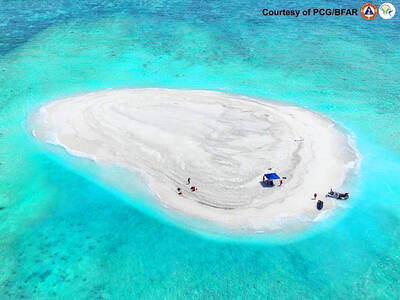The US$2.3 trillion government spending package that US President Donald Trump finally signed on Sunday evening incorporates the Taiwan Assurance Act of 2020, as well as money to support activities under the Global Cooperation and Training Framework initiative launched in 2015.
The government yesterday voiced gratitude for the passage of the act, with Presidential Office spokesman Xavier Chang (張惇涵) saying that Taiwan would continue deepening its partnership with the US and be a force for good in the world.
H.R. 133, or the Consolidated Appropriations Act of 2021, covers the fiscal year that ends on Sept. 30 next year and covers a US$900 billion COVID-19 pandemic relief package, US$1.4 trillion to fund government agencies, and backing for Taiwan’s defense capacity and its participation in international organizations.

Photo: CNA
The Taiwan Assurance Act supports the deepening of US-Taiwan ties on the basis of the 1979 Taiwan Relations Act (TRA).
It states that the US Congress believes Taiwan is a vital part of the US’ “Free and Open Indo-Pacific Strategy” and as such the government should support Taiwan’s continued pursuit of asymmetric capabilities.
“The US should conduct regular sales and transfers of defense articles to Taiwan in order to enhance its self-defense capabilities, particularly its efforts to develop and integrate asymmetric capabilities, including undersea warfare and air defense capabilities, into its military forces,” the new act states.
In terms of Taiwan’s exclusion from international organizations due to Beijing’s opposition, the US Congress believes such a situation is detrimental to global health, civilian air safety and efforts to counter transnational crime, as well as having a negative impact on Taiwan’s democracy.
The act stresses that it is the policy of the US to advocate for Taiwan’s meaningful participation in the UN, the WHO, the International Civil Aviation Organization, the International Criminal Police Organization and other international bodies, as appropriate.
The US should also advocate for Taiwan’s membership in the Food and Agriculture Organization, the UN Educational, Scientific and Cultural Organization and other international organizations for which statehood is not a requirement for membership, it added.
The “Review of Department of State Taiwan Guidelines” states that the US secretary of state must conduct a review of the department’s guidance that governs relations with Taiwan not later than 180 days after the enactment of the law.
It also said the State Department’s guidance regarding relations with Taiwan should reflect the long-standing, comprehensive and values-based relationship the US shares with Taiwan, and contribute to the peaceful resolution of cross-strait issues.
The Ministry of Foreign Affairs also issued a statement thanking “the US government and Congress for supporting Taiwan-US relations through concrete actions.”
The ministry said the new law includes US$3 million to support activities under the Global Cooperation and Training Framework, which helps bring Taiwan’s expertise in areas such as public health, disaster relief, women’s empowerment and cybersecurity to the global stage.
Meanwhile, in Beijing, Chinese Ministry of Foreign Affairs spokesman Zhao Lijian (趙立堅) said that China was “resolutely opposed” to the Taiwan Assurance Act of 2020 as well as the Tibetan Policy and Support Act of 2020, which was also part of the omnibus bill signed by Trump on Sunday.
The US should not put the parts of the acts which “target China” into effect to avoid harming Sino-US relations, as they were an interference in China’s internal affairs, Zhao told reporters at a regular briefing at the ministry.
The Tibet act states that sanctions should be put on Chinese officials who interfere in the selection of the successor to the exiled Dalai Lama.
Additional reporting by Su Yung-yao and agencies

MORE VISITORS: The Tourism Administration said that it is seeing positive prospects in its efforts to expand the tourism market in North America and Europe Taiwan has been ranked as the cheapest place in the world to travel to this year, based on a list recommended by NerdWallet. The San Francisco-based personal finance company said that Taiwan topped the list of 16 nations it chose for budget travelers because US tourists do not need visas and travelers can easily have a good meal for less than US$10. A bus ride in Taipei costs just under US$0.50, while subway rides start at US$0.60, the firm said, adding that public transportation in Taiwan is easy to navigate. The firm also called Taiwan a “food lover’s paradise,” citing inexpensive breakfast stalls

US PUBLICATION: The results indicated a change in attitude after a 2023 survey showed 55 percent supported full-scale war to achieve unification, the report said More than half of Chinese were against the use of force to unify with Taiwan under any circumstances, a survey conducted by the Atlanta, Georgia-based Carter Center and Emory University found. The survey results, which were released on Wednesday in a report titled “Sovereignty, Security, & US-China Relations: Chinese Public Opinion,” showed that 55.1 percent of respondents agreed or somewhat agreed that “the Taiwan problem should not be resolved using force under any circumstances,” while 24.5 percent “strongly” or “somewhat” disagreed with the statement. The results indicated a change in attitude after a survey published in “Assessing Public Support for (Non)Peaceful Unification

PLUGGING HOLES: The amendments would bring the legislation in line with systems found in other countries such as Japan and the US, Legislator Chen Kuan-ting said Democratic Progressive Party (DPP) Legislator Chen Kuan-ting (陳冠廷) has proposed amending national security legislation amid a spate of espionage cases. Potential gaps in security vetting procedures for personnel with access to sensitive information prompted him to propose the amendments, which would introduce changes to Article 14 of the Classified National Security Information Protection Act (國家機密保護法), Chen said yesterday. The proposal, which aims to enhance interagency vetting procedures and reduce the risk of classified information leaks, would establish a comprehensive security clearance system in Taiwan, he said. The amendment would require character and loyalty checks for civil servants and intelligence personnel prior to

The China Coast Guard has seized control of a disputed reef near a major Philippine military outpost in the South China Sea, Beijing’s state media said, adding to longstanding territorial tensions with Manila. Beijing claims sovereignty over almost all of the South China Sea and has waved away competing assertions from other countries as well as an international ruling that its position has no legal basis. China and the Philippines have engaged in months of confrontations in the contested waters, and Manila is taking part in sweeping joint military drills with the US which Beijing has slammed as destabilizing. The Chinese coast guard